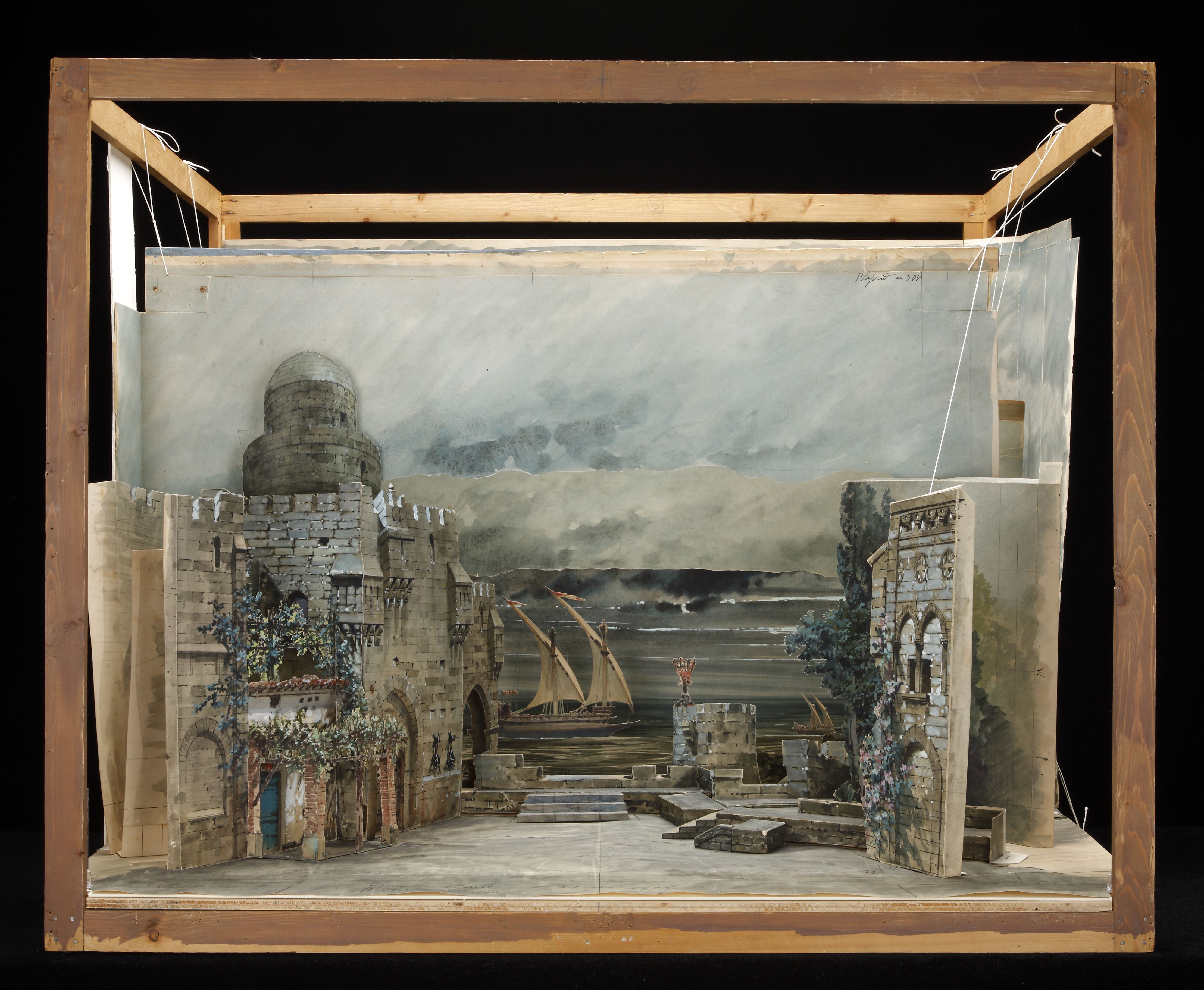|
Scenography
Scenography (inclusive of scenic design, lighting design, sound design, costume design) is a practice of crafting stage environments or atmospheres. In the contemporary English usage, scenography is the combination of technological and material stagecrafts to represent, enact, and produce a sense of place in performance. While inclusive of the techniques of scenic design and set design, scenography is a holistic approach to the study and practice of all aspects of design in performance. Etymology and cultural interpretations The term scenography is of Greek origin (''skēnē'', meaning 'stage or scene building'; ''grapho'', meaning 'to describe') originally detailed within Aristotle's ''Poetics'' as 'skenographia'. Nevertheless, within continental Europe, the term has been closely aligned with the professional practice of scénographie and is synonymous with the English-language term 'theatre design Scenic design (also known as scenography, stage design, or set design) is ... [...More Info...] [...Related Items...] OR: [Wikipedia] [Google] [Baidu] |
Scenographer
A scenographer or production designer, develops the appearance of a stage design, a TV or movie set, a gaming environment, a trade fair exhibition design or a museum experience exhibition design. The term originated in theater. A scenographer works together with the theater director to make the message come through in the best way they think possible, the director having the leading role and responsibility particularly for dramatic aspects - such as casting, acting, and direction - and the scenographer primarily responsible for the visual aspects or "look" of the production - which often includes scenery or sets, lighting, and costumes, and may include projections or other aspects. While a common role in theatrical production teams in most countries, the position of scenographer is very uncommon in the United States, where this task is generally parcelled out among several people, principally the scenic or set designer who generally spearheads the visual aspects of the production. ... [...More Info...] [...Related Items...] OR: [Wikipedia] [Google] [Baidu] |
Scenic Design
Scenic design (also known as scenography, stage design, or set design) is the creation of theatrical, as well as film or television scenery. Scenic designers come from a variety of artistic backgrounds, but in recent years, are mostly trained professionals, holding B.F.A. or M.F.A. degrees in theatre arts. Scenic designers create sets and scenery that aim to support the overall artistic goals of the production. There has been some consideration that scenic design is also production design; however, it is generally considered to be a part of the visual production of a film or television. Scenic designer The scenic designer works with the director and other designers to establish an overall visual concept for the production and design the stage environment. They are responsible for developing a complete set of design drawings that include the following: *''basic ground plan'' showing all stationary and scenic elements; *''composite ground plan'' showing all moving scenic ... [...More Info...] [...Related Items...] OR: [Wikipedia] [Google] [Baidu] |
Stage Set
Set construction is the process undertaken by a construction manager to build full-scale scenery, as specified by a production designer or art director working in collaboration with the director of a production to create a set for a theatrical, film, or television production. The set designer produces a scale model, scale drawings, paint elevations (a scale painting supplied to the scenic painter of each element that requires painting), and research about props, textures, and so on. Scale drawings typically include a groundplan, elevation, and section of the complete set, as well as more detailed drawings of individual scenic elements which, in theatrical productions, may be static, flown, or built onto scenery wagons. Models and paint elevations are frequently hand-produced, though in recent years, many Production Designers and most commercial theatres have begun producing scale drawings with the aid of computer drafting programs such as AutoCAD or Vectorworks. Theater I ... [...More Info...] [...Related Items...] OR: [Wikipedia] [Google] [Baidu] |
Galli Da Bibiena Family
The Galli–Bibiena family, or Galli da Bibiena (also spelled "Bibbiena"), was a family of Italian artists of the 17th and 18th centuries, including: "Ferdinando Galli Bibiena Online" (overview), John Malyon, ''Artcyclopedia'', 2005, Artcyclopedia.com webpage: "Bibiena, Galli da, Family" (history), ''Encyclopædia Britannica Online'', 18-November-2006, Britannica.com webpage: EB-Bibienas Galli de Bibiena collection at the Canadian Centre for Architecture, webpage: "Baroque Scenography: The Galli Bibiena Family" "Galli–Bibiena, Ferdinando" (history), ''Encyclopedia of Austria'', 2006, Aeiou-Austria webpage: : has dates, Farnese dynasty, travel to Barcelona for Karl VI. "Artists' Biographies: Galli–Bibiena alli da Bibiena" ''artnet - The art world online'', NY, 2006, webpage: an-GBibiena ("artnet" is a trademark of artnet Worldwide Corporation). * father, Giovanni Maria Galli da Bibiena (1625–1665) * daughter Maria Oriana Galli Bibiena (1656 ... [...More Info...] [...Related Items...] OR: [Wikipedia] [Google] [Baidu] |
Poetics
Poetics is the theory of structure, form, and discourse within literature, and, in particular, within poetry. History The term ''poetics'' derives from the Ancient Greek ποιητικός ''poietikos'' "pertaining to poetry"; also "creative" and "productive". In the Western world, the development and evolution of poetics featured three artistic movements concerned with poetical composition: (i) the formalist, (2) the objectivist, and (iii) the Aristotelian. (see the '' Poetics''). Aristotle's ''Poetics'' is the first extant philosophical treatise to focus on literary theory. The work was lost to the Western world for a long time. It was available in the Middle Ages and early Renaissance only through a Latin translation of an Arabic commentary written by Averroes and translated by Hermannus Alemannus in 1256. The accurate Greek-Latin translation made by William of Moerbeke in 1278 was virtually ignored. The Arabic translation departed widely in vocabulary from the original '' ... [...More Info...] [...Related Items...] OR: [Wikipedia] [Google] [Baidu] |
Alessandro Sanquirico
Alessandro Sanquirico (27 July 1777, in Milan – 12 March 1849, in Milan) was an Italian scenic designer, architect, and painter. He began his career in conjunction with leading artists of the time such as Paolo Landriani, Giovanni Pedroni, Giovanni Perego, and Georgio Fuentes.Sheren in Grove 1998, pp. 168–169. Additionally, he studied architecture and perspective with Giuseppe Piermarini, the architect of the La Scala opera house. Altogether, he designed over 300 productions for that house, including many premières. Specifically, they included four operas by Vincenzo Bellini. Works For fifteen years, from 1818 to 1832, Sanquirico dominated the visual style of La Scala, not only on stage, but also in the auditorium. He designed the ballets of Salvatore Viganò at the beginning of the 19th century, and the world premières of Rossini's ''La gazza ladra'', Bellini's ''Il pirata'', ''La straniera'', ''La sonnambula'' as well as ''Norma'' in 1831. His set designs were prepa ... [...More Info...] [...Related Items...] OR: [Wikipedia] [Google] [Baidu] |
Stage Lighting
Stage lighting is the craft of lighting as it applies to the production of theater, dance, opera, and other performance arts. Stage Lighting Design Principle and Process Several different types of s are used in this discipline. theatrecrafts' Types of Lanterns. In addition to basic lighting, modern stage lighting can also include special effects, such as [...More Info...] [...Related Items...] OR: [Wikipedia] [Google] [Baidu] |
Sound Design
Sound design is the art and practice of creating sound tracks for a variety of needs. It involves specifying, acquiring or creating auditory elements using audio production techniques and tools. It is employed in a variety of disciplines including filmmaking, television production, video game development, theatre, sound recording and reproduction, live performance, sound art, post-production, radio, new media and musical instrument development. Sound design commonly involves performing (see e.g. foley) and editing of previously composed or recorded audio, such as sound effects and dialogue for the purposes of the medium, but it can also involve creating sounds from scratch through synthesizers. A sound designer is one who practices sound design. History The use of sound to evoke emotion, reflect mood and underscore actions in plays and dances began in prehistoric times. At its earliest, it was used in religious practices for healing or recreation. In ancient Japan, theatrical ... [...More Info...] [...Related Items...] OR: [Wikipedia] [Google] [Baidu] |
Luigi Vimercati
is a fictional character featured in video games and related media released by Nintendo. Created by Japanese video game designer Shigeru Miyamoto, Luigi is portrayed as the younger fraternal twin brother and sidekick of Mario, Nintendo's mascot. Luigi appears in many games throughout the Mario (franchise), ''Mario'' franchise, oftentimes accompanying his brother. Luigi first appeared in the 1983 Game & Watch game ''List of LCD games featuring Mario#Mario Bros., Mario Bros.'', where he is the character controlled by the second player. He would retain this role in many future games, including ''Mario Bros.'', ''Super Mario Bros.'', ''Super Mario Bros. 3'', ''Super Mario World'', among other titles. He was first available as a primary character in ''Super Mario Bros. 2''. In more recent appearances, Luigi's role became increasingly restricted to spinoffs, such as the ''Mario Party'' and ''Mario Kart'' series; however, he has been featured in a starring role in ''Nelsonic Industr ... [...More Info...] [...Related Items...] OR: [Wikipedia] [Google] [Baidu] |
Angelo Moja
Angelo is an Italian masculine given name and surname meaning "angel", or "messenger". People People with the given name *Angelo Accattino (born 1966), Italian prelate of the Catholic Church * Angelo Acciaioli (bishop) (1298–1357), Italian Roman Catholic bishop from Florence *Angelo Achini or Angiolo Achini (1850–1930), Italian painter * Angelo Agostini (1843–1910), illustrator, journalist and founder of several publications, and although born in Italy, is considered the first Brazilian cartoonist *Angelo Aimo (born 1964), Italian footballer *Angelo Albanesi (late 1765–1784), Italian engraver *Angelo Alistar (born 1975), Romanian footballer * Angelo Ambrogini Poliziano (1454–1494), Florentine classical scholar and poet *Angelo Andres (1851–1934), Italian zoologist *Angelo Anelli (1761–1820), Italian *Angelo Angeli (1864–1931), Italian chemist *Angelo Anquilletti (1943–2015), Italian football defender *Angelo Antonino Pipitone (born 1943), member of the Sicilia ... [...More Info...] [...Related Items...] OR: [Wikipedia] [Google] [Baidu] |
Enrico Rovecchi
Enrico is both an Italian masculine given name and a surname, Enrico means homeowner, or king, derived from ''Heinrich'' of Germanic origin. It is also a given name in Ladino. Equivalents in other languages are Henry (English), Henri ( French), Enrique (Spanish), Henrique (Portuguese) and Hendrik (Dutch). Notable people with the name include: Given name * Enrico Albertosi (born 1939), Italian former football goalkeeper * Enrico Alfonso (born 1988), Italian football player * Enrico Alvino (1808–1872), Italian architect and urban designer * Enrico Annoni (born 1966), retired Italian professional footballer * Enrico Arrigoni (1894–1986), Italian individualist anarchist * Enrico Baj (1924–2003), Italian artist and art writer * Enrico Banducci (1922–2007), American impresario * Enrico Barone (1859–1924), Italian economist * Enrico Berlinguer (1923–1984), Italian politician * Enrico Bertaggia (born 1964), Italian former racing driver * Enrico Betti (1823–1892), Italian ma ... [...More Info...] [...Related Items...] OR: [Wikipedia] [Google] [Baidu] |





